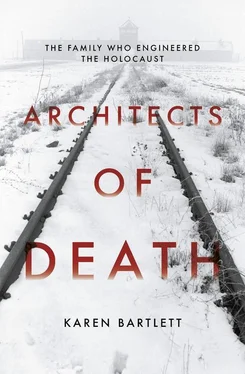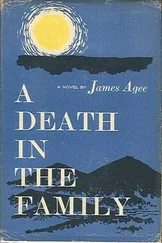Prüfer’s exact design is no longer in existence, but it appears to have been based on industrial ring ovens which operated a system of continuous combustion through one central source of fuel – reducing costs by up to 70 per cent. Using this system, Prüfer’s oven, which his quote revealed to be twice as big and twice as expensive as an eight-muffle oven, would add coal from above, which would then land directly on piles of burning corpses.
In his trial after the war, Rudolf Höss confirmed that such a system was planned ‘in the form of an enormous underground brick factory with a ring oven’. Although Prüfer’s design was accepted, like Sander’s it was never built. Initial plans to build in 1943 were put on hold as Ludwig Topf explained to the SS that the company was at full capacity, and could not take any additional orders for ovens. When the project was reconsidered in 1944, Höss claimed that the Allied advance meant the Nazi genocide had run out of time.
From the very beginning Topf and Sons was involved in helping the SS develop new means of disposing of its victims – but its complicity in the Holocaust went much further. From 1940 onwards, Topf and Sons took part in discussions and decisions about ventilation systems for the crematoria – and by 1943 it was developing ventilation technology for the gas chambers. In essence, Topf and Sons was devising more efficient ways of murdering people.
The person responsible for developing ventilation technology was 40-year-old Karl Schultze who originally worked in Department D, but was promoted in 1941 to run a department of his own, Department B, which developed industrial inward and outward ventilation systems, hot-air heating systems and dust-extraction systems. Schultze, who was married with no children, had joined the company in 1928 after being educated at technical college. Like Prüfer, he was not made an authorised company representative, so his business deals had to be approved by Fritz Sander or Paul Erdmann.
Between December 1940 and September 1941, Schultze submitted four designs for a ventilation system for Crematorium I at Auschwitz. In February 1941, the SS had bought and installed a temporary ventilation system from the Cologne-based Frederick Boos company, which was responsible for the heating systems in the camp. This, however, was deemed unsatisfactory, and hindered the Gestapo in their efforts to murder people in the room next door. ‘The current system has become useless’, complained the Head of the Political Department and Criminal Secretary, Maximilian Grabner, on 7 June 1941. Grabner, who was the second most powerful person in the camp after Rudolf Höss, went on to explain that ‘When the second oven is in use – as is now the case on an almost daily basis – the morgue ventilation hatch has to be closed, as otherwise the hot air from the flue gets in, and this is the very opposite of the ventilation effect required.’ Despite this, the temporary system remained in place, and the system supplied by Topf in April 1942 was not installed.
The greatest concern to the SS was the amount of time it took to decontaminate a room or building after a gassing had taken place – up to two days for the entire building in the case of the original gassings that were carried out in the Auschwitz cellars. To overcome this, Prüfer and Schultze were involved from the earliest stages in the planning for building Crematoria II to V. As Annegret Schüle charts in her book, there has been disagreement between historians about exactly when the SS decided to add gas chambers to each crematorium, but by the time of their completion in March 1943 each had a gas chamber attached to it.
Topf and Sons must have known about these plans no later than mid-1942, as Kurt Prüfer and the SS discussed plans for a ventilation system for Crematoria II and III at their meeting on site in August of that year. The minutes of the meeting specifically note that the construction of Crematorium II would have an inward and outward ventilation system – something that would only be necessary if there was a gas chamber. On 27 November 1942, SS Untersturmführer Wolter, a structural engineer at Auschwitz, notes that he has spoken to Prüfer on the phone in relation to Crematorium II, and that Prüfer had said that ‘the company would have a fitter available in about a week’s time to install the outward ventilation system once the ceilings of the special cellar are ready’. In SS terminology a ‘special cellar’ was a gas chamber. The SS later ordered two ventilation systems for Crematoria IV and V, where gas chambers had not originally been planned, but were added later. Karl Schultze prepared a quotation for each order in June 1943, and the ventilations systems were dispatched in December that year (though never installed in the case of Crematorium IV).
As the constant changes in plans for the camp show, Auschwitz-Birkenau was now being promoted at the highest levels of the Nazi regime as a ‘showcase’ elimination and work camp, and its development was progressing under the watchful eye of Heinrich Himmler himself. For the SS this added an extra pressure to a process that was often chaotic and prone to delays and breakdowns. Their response was to work ever more closely with Topf and Sons, consulting them in areas of work where the company had no expertise, and blaming them when things went wrong.
In December 1942, the SS construction unit at Auschwitz informed Topf and Sons that Himmler had personally set new deadlines for the completion of the crematorium. These deadlines were a month earlier than those the SS at the camp had originally suggested, but when the SS at Auschwitz replied to their masters in Berlin to say that the deadlines were impossible and could not be met, Hans Kammler agreed to a postponement only on the basis that he received weekly progress reports, and that every effort was made to meet the original deadline.
In January 1943, the new deadlines were agreed upon with Prüfer, giving the company two additional weeks to work on Crematorium II and an extra month for Crematorium IV. The reliability of Topf and Sons, and the efforts of all concerned to work under ‘extreme pressure’ was something the SS didn’t hesitate to show off about in their self-serving reports to their superiors. They had deployed all labourers and ‘worked around the clock’ in sub-zero temperatures, and despite many difficulties, to complete Crematorium II, SS Hauptsturmführer Bischoff wrote to Kammler in Berlin – forwarding a report from Prüfer which stated that ‘the inspection of the above-mentioned crematorium, complete with its internal fittings, showed that despite the scale of the task and the difficulties caused by bad weather and problems acquiring materials, the work was performed very quickly’. Bischoff concluded his report to Kammler by praising Prüfer, and informing the SS in Berlin that the ovens had been fired up in Prüfer’s presence ‘and are working perfectly’.
Despite Bischoff stressing that work on the crematorium was to be given ‘the absolute top priority’, with two teams of labourers working in shifts if necessary, the project was beset by problems caused by snow and permafrost, a severe shortage of materials and labourers being transferred to other work. To rectify this, the SS sent a telegram to Topf and Sons to demand that Prüfer work on site for at least two to three days per week as part of the construction management unit. By now, however, Topf and Sons, and Prüfer in particular, knew their power. The company replied by post, rather than by telegram, and stated that of course Prüfer would be available to frequently inspect the work at Auschwitz. This rather vague and leisurely reply showed that the company were not afraid of the SS, nor did they have any inclination to sacrifice other work or priorities to meet the demands from Auschwitz.
Читать дальше












